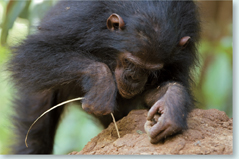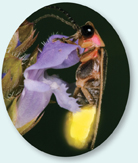29 Study Guide
 Evolution
Evolution
Animal behavior may be innate, learned, or a combination of both. An animal's behavior is affected by other organisms and changes in its environment.
29.1 Elements of Behavior
 If a behavior that is influenced by genes increases an individual's fitness, that behavior will tend to spread through a population. Over many generations, various kinds of adaptive behaviors can play central roles in the survival of populations and species.
If a behavior that is influenced by genes increases an individual's fitness, that behavior will tend to spread through a population. Over many generations, various kinds of adaptive behaviors can play central roles in the survival of populations and species.
 Innate behaviors appear in fully functional form the first time they are performed, even though the animal has had no previous experience with the stimuli to which it responds. Innate behaviors are also called instincts.
Innate behaviors appear in fully functional form the first time they are performed, even though the animal has had no previous experience with the stimuli to which it responds. Innate behaviors are also called instincts.
 The four major types of learning are habituation, classical conditioning, operant conditioning, and insight learning.
The four major types of learning are habituation, classical conditioning, operant conditioning, and insight learning.
 Many complex behaviors combine innate behavior with learning.
Many complex behaviors combine innate behavior with learning.
behavior (840)
classical conditioning (843)
innate behavior (841)
operant conditioning (843)
learning (842)
insight learning (843)
habituation (842)
imprinting (844)

29.2 Animals in Their Environments
 Many animals respond to periodic changes in the environment with daily or seasonal cycles of behavior.
Many animals respond to periodic changes in the environment with daily or seasonal cycles of behavior.
 Choosing mates, defending or claiming territories or resources, and forming social groups can increase evolutionary fitness.
Choosing mates, defending or claiming territories or resources, and forming social groups can increase evolutionary fitness.
 Animals may use a variety of signals to communicate with one another. Some animals are also capable of language.
Animals may use a variety of signals to communicate with one another. Some animals are also capable of language.
circadian rhythm (847)
society (848) migration (847)
kin selection (849) courtship (848)
communication (850)
territory (848)
language (851)
aggression (848)

Think Visually Using information from this chapter, complete the following concept map:

Table of Contents
- Formulas and Equations
- Applying Formulas and Equations
- Mean, Median, and Mode
- Estimation
- Using Measurements in Calculations
- Effects of Measurement Errors
- Accuracy
- Precision
- Comparing Accuracy and Precision
- Significant Figures
- Calculating With Significant Figures
- Scientific Notation
- Calculating With Scientific Notation
- Dimensional Analysis
- Applying Dimensional Analysis





